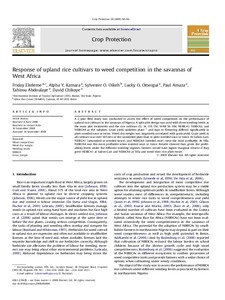| dc.contributor.author | Ekeleme, F. |
| dc.contributor.author | Kamara, A.Y. |
| dc.contributor.author | Oikeh, S.O. |
| dc.contributor.author | Omoigui, L.O. |
| dc.contributor.author | Amaza, P. |
| dc.contributor.author | Abdoulaye, Tahirou |
| dc.contributor.author | Chikoye, D. |
| dc.date.accessioned | 2019-12-04T11:11:43Z |
| dc.date.available | 2019-12-04T11:11:43Z |
| dc.date.issued | 2009 |
| dc.identifier.citation | Ekeleme, F., Kamara, A.Y., Oikeh, S.O., Omoigui, L.O., Amaza, P., Abdoulaye, T. & Chikoye, D. (2009). Response of upland rice cultivars to weed competition in the savannas of West Africa. Crop Protection, 28(1), 90-96. |
| dc.identifier.issn | 0261-2194 |
| dc.identifier.uri | https://hdl.handle.net/20.500.12478/2486 |
| dc.description.abstract | A 2-year field study was conducted to assess the effect of weed competition on the performance ofupland rice cultivars in the savannas of Nigeria. A split-plot design was used with three weeding levels asthe main plot treatments and the rice cultivars CG 14, ITA 150, WAB 56-104, NERICA1, NERICA2, andNERICA4 as the subplots. Grain yield, spikelets plant 1and days to flowering differed significantly inplots weeded once or twice. Weed dry weight was negatively correlated with grain yield. Grain yield inall cultivars was over 50% less in the unweeded plots than in plots weeded once or twice. At Sabon-Gari,NERICA1 (unweeded or weeded twice), and NERICA4 (weeded once) were the most profitable. At Tilla,NERICA4 was the most profitable when weeded once or twice. Results showed that, given the profit-ability levels under the different weeding regimes, farmers would have higher marginal returns if theygrew NERICA1 at Sabon-Gari and NERICA4 at Tilla and weed their rice plots twice. |
| dc.description.sponsorship | Canadian International Development Agency |
| dc.format.extent | 90-96 |
| dc.language.iso | en |
| dc.subject | Weed Competition |
| dc.subject | Weed Dry Weight |
| dc.subject | Weeding Levels |
| dc.subject | Nerica |
| dc.subject | Gross Margin |
| dc.subject | Smallholders |
| dc.subject | Herbicides |
| dc.subject | Rice Cultivars |
| dc.title | Response of upland rice cultivars to weed competition in the savannas of West Africa |
| dc.type | Journal Article |
| dc.description.version | Peer Review |
| cg.contributor.affiliation | International Institute of Tropical Agriculture |
| cg.contributor.affiliation | Africa Rice Center |
| cg.coverage.region | Africa |
| cg.coverage.region | West Africa |
| cg.coverage.country | Nigeria |
| cg.coverage.country | Togo |
| cg.isijournal | ISI Journal |
| cg.authorship.types | CGIAR and developing country institute |
| cg.iitasubject | Food Security |
| cg.iitasubject | Grain Legumes |
| cg.iitasubject | Smallholder Farmers |
| cg.iitasubject | Plant Ecology |
| cg.iitasubject | Plant Production |
| cg.iitasubject | Farm Management |
| cg.iitasubject | Weeds |
| cg.iitasubject | Crop Systems |
| cg.journal | Crop Protection |
| cg.howpublished | Formally Published |
| cg.accessibilitystatus | Limited Access |
| local.dspaceid | 93237 |
| cg.identifier.doi | https://dx.doi.org/10.1016/j.cropro.2008.09.006 |

